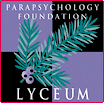 |
 |
| Click here for the PF Lyceum Site Index
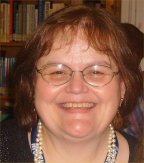
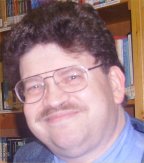 PF Lyceum Blog #27 Posted December 18th, 2008 Nancy L. Zingrone, Ph.D. and Carlos S. Alvarado, Ph.D. Parapsychology Foundation email: zingrone@parapsychology.org email: alvarado@parapsychology.org 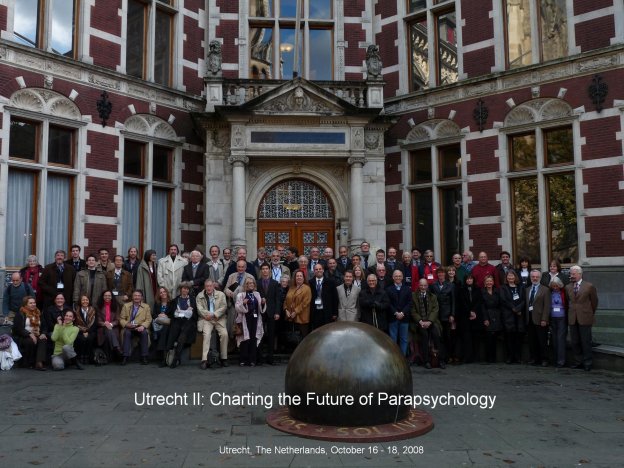
Photo taken by: Emel Sebuktekin Front Row: Prof. Nadir Ganz, Dr. Anneli Goulding, Danielle Ferrari Fabri, Dr. Djohar Si Ahmed, Drs. Maggie Eybrechts, Prof. Dr. Hans Gerding, Ingrid Kloosterman, Drs. Eva Lobach, Dr. Joop Houtkooper, Dr. Harald Walach, Dr. Jeanne Achterberg, Tim Kramer, Eileen Coly, Lisette Coly, Drs. Wim Kramer, Dr. Etzel Cardeña, Dr. Bill Roll, Dr. Hoyt Edge, Frans Snel, Dr. Thilo Hinterberger, Dr. Christine Simmonds-Moore, Elizabeth Roxburgh, Dr. Martina Belz, Dr. Deborah Delanoy, Dr. Roger Nelson, Reinhilde Nelson, Dr. Dieter Vaitl. Middle row starting behind Tim Kramer: Dr. Mário Simões, Prof. Dr. Brian Josephson, Dr. Mario Varvoglis, Dr. Wendy Cousins, Prof. Dr. D. J. West. Back row from left: Dr. Zoltán Vassy, Loes Modderman, Dr. Walter von Lucadou, Thomas Rabeyron, Renaud Evrard, Dr. Paul-Luis Rabeyron, Hideyuki Kokubo, Egil Asprem, Dr. Friederike Schriever, Gerd Hövelmann, Annemarie Visser, Dr. Suitbert Ertel, hidden by Dr. Ertel Dr. Kaare Claudewitz, Dr. Jiri Wackermann, Fabio da Silva, Dr. York Dobyns, Dr. Peter van der Sijde, Jóse Raul Naranjo, Drs. Maurice van Luijtelaar, Dr. Giovanni Iannuzzo, Prof. Peter Mulacz, Dr. Massimo Biondi, Dipl. Psych. Eberhard Bauer, Dr. Peter Bancel, Dr. Chris Roe, Dr. Bernard Carr, Dr. Sally Feather, Dr. Carlos Alvarado, Drs. Hans Michels, Dr. Joseph Glickson, Dr. Bob van de Castle, Dr. Richard Shoup, Dr. Wellington Zangari, Dr. Fátima Machado, Dr. Nancy Zingrone Missing: Dr. Edwin May, Martine Busch, Dr. Marios Kittenis, Dr. David Luke, Prof. Dr. Klaas von Egmond, Susan MacWilliam
Between October 15th and 18th of 2008 an important meeting on parapsychology took place in Utrecht in the Netherlands. The conference was called “Utrecht II: Charting the Future of Parapsychology.” Jointly organized by the Parapsychology Foundation and the Het Johan Borgman Fonds (HJBF), the purpose of the conference was to provide a forum for discussion of where we are now and where we are going in scientific parapsychology. Beginning in the fall of 2007, the Advisory Committee (Dipl. Psych. Eberhard Bauer of the IGPP in Germany, Dr. Etzel Cardeña of Lund University in Sweden, Prof. Dr. Hans Gerding of the Parapsychology Institute in the Netherlands, Gerd Hövelmann of Hövelmann Communications in Germany, and Dr. Roger Nelson of the Global Consciousness Project in the United States) were given the charge of proposing two different types of conference programs to fit the remit of assessing the past 55 years of the field and charting the next 50 years. Advisory Committee members provided complete conference rosters with first and second choices for paper presenters and invited address givers, with one organizational scheme focusing on methodologies and one focusing on broad research areas. Conference moderator, Dr. Chris Roe, who was also brought on board in 2007, was given the opportunity both to propose his own preferred conference scheme and to comment on the plans submitted by the members of the Advisory Committee. Both the Moderator and the Committee members also put together lists of individuals to be invited as observers. In early 2008, we, in our roles as the Conference Bureau, worked through the materials submitted by the Moderator and the Committee, and put together final recommendations that accommodated the most preferred organizational structure and the most preferred first and second choice invited address givers and paper presenters. We also, working with Lisette and Eileen Coly — the Executive Director and President of the Parapsychology Foundation, respectively — collated the suggestions for observers into a prioritized list of invitees. A few weeks later, during Drs. Wim Kramer’s visit to the Eileen J. Garrett Library, the Conference Board (Lisette Coly and Drs. Wim Kramer) went over our recommendations and then held two meetings with us and Eileen Coly during which the conference structure, topics, and invitation lists were confirmed. As we sent out invitations in March and April, Drs. Wim Kramer, back in the Netherlands, began the process of securing the venues and arranging the details for accommodations, travel and the meeting amenities, with the much appreciated financial support of the HJBF board. (For the biographies of the Organizers, Moderators, Invited Address Givers and Paper Presenters, click here. For the biographies of the Observers, click here.) Set out in more detail on the main page of the Utrecht II section of this website, the philosophy of the conference was to pull together a prestigious, multi-generational and multi-national group of workers in the field of scientific parapsychology, whose expertise and energy would match or exceed that of the scholars and scientists who had gathered in 1953 at Utrecht I. That earlier conference had been a milestone in the 20th-century history of the field, helping to shape the 50 years that followed. (To honor the earlier conference, we also extended invitations to veterans of Utrecht I. Prof. Dr. Donald West and Dr. William Roll were able to join us.) We all — the sponsoring foundations, the Conference Board and Bureau, the Moderator and the Advisory Committee members — hoped that Utrecht II would also chart the future of the field, through the gathered scholars, scientists and talented post-graduate students, in the conference sessions and coffee breaks, dinners, after-hours and off program activities, as well as in the final discussion session dedicated specifically to the topic. (For the full newly-illustrated and linked conference program, click here. For the abstracts and powerpoints of the presentations, click here.) How well Utrecht II succeeded in this final goal remains to be seen. A number of participants have sent us comments on their experience which are available by clicking here. It is hoped that other attendees will be inspired to submit comments as well. We, of course, believe we were successful in crafting a conference that honored fully the model of the First International Conference of Parapsychological Studies held in Utrecht in 1953. The first Utrecht conference was the first major project in a long list of contributions to the field made by the Parapsychology Foundation. (For a paper on the history of the Foundation click here.) Utrecht I was also a milestone in the history of parapsychology in the Netherlands, and in providing support and arranging the venues and amenities, the HJBF honored the participation of the University of Utrecht in the original conference as well. (The powerpoints of Drs. Wim Kramer’s introductory remarks on the first day of the conference and on the second day when we occupied the venue of Utrecht I provide some insight into this. They are available in click-throughs on the newly-illustrated conference program which, in addition to links to abstracts, powerpoints and biographies, also has links to the photo galleries.) The Honorable Frances P. Bolton, a U.S. “Congressman” from the state of Ohio (she preferred the term to “Congresswoman”) and also a Standard Oil heiress, provided the funding for Utrecht I. Consequently, money was no object in 1953. Utrecht I took place over seven days with most of the participants and presenters flown in on chartered KLM airplanes. Once at the conference, everyone received paid-for accommodations and meals and a daily conference newsletter summarizing the day’s events that was printed overnight and delivered with the morning coffee. Participants of Utrecht I also went home with souvenirs of various kinds, including a phonograph album of the plenary sessions. In the modern world, of course, such largesse is no longer possible. At Utrecht II the concessions to modern times included shrinking the conference to three days of substantive sessions and requiring observers to be self-funding. 
The NH Centre Utrecht Hotel [Photo taken by Nancy Zingrone.] But thanks to the generosity of the HJBF, all our invited speakers and paper presenters were brought to Utrecht all expenses paid, and on two of the conference days lunch was offered to everyone in attendance. All of the HJBF and PF staff, and the invited speakers and paper presenters stayed in the Utrecht I hotel, called the Hotel Pays-Bas in 1953 and now called the NH Utrecht Centre. The HJBF also provided the registration materials and the conference and reception venues without charging any registration fees as well as organizing the presence of an antique bookseller, Lilith in the foyer of the Driehoek. On Friday, Drs. Wim Kramer also provided an off-program film festival in which recently-recovered 16mm films of the Dutch psychic Gerard Croiset, as well as films of Professor Hans Bender, Dr. J. B. Rhine and Dr. Louisa E. Rhine were presented. The Parapsychology Institute in Utrecht hosted preregistration and the closing reception. The PF provided the complimentary copy of the Utrecht I proceedings given out to all registrants, as well as the food and drink provided at the closing reception. The HJBF’s “staff on the ground” in Utrecht included Drs. Wim Kramer, and the HJBF hostesses, Annemarie Visser, and Emel Sebuktekin who was also the “official” photographer. The PF’s “staff on the ground” included the Colys, us, and the PF’s Film Archivist, Susan MacWilliam, who filmed the proceedings for the archives. 
Conference Moderator Dr. Chris Roe introducing Prof. Dr. Brian Josephson and his invited address, “Self-Organising Reality” in the Senaatszaal, University of Utrecht. [Photo taken by Nancy Zingrone.] The Content Because the core of the conference structure was limited to four paper sessions, an attempt was made to represent the most important aspects of modern scientific parapsychology. Experimental and field research, theory, and clinical and medical components were included. Chaired by Dr. Chris Roe the four paper sessions were: Expressions of Psi in Life Clinical and Medical Connections Theories, Implications, New Directions The first paper session focused on experimental approaches to psi research and included a report on presentiment research, the Global Consciousness Project, and the development of a neuropsychological approach. The second paper session revolved around spontaneous case research with an emphasis on dream research and extrasensory perception, hauntings and poltergeist research and the psychology of experiencers. The third paper session included a paper on dealing with seemingly paranormal experiences in the clinical setting, on distant healing and spirituality research as the legacy of traditional parapsychology. The final session revolved around theoretical models drawn from philosophy and from physics, the first of these dealing with time and the second taking a more general approach to the area. In addition to the paper session, five invited addresses were given: Discussing Parapsychology at Utrecht: The First International Conference of Parapsychological Studies Parapsychology in the University Setting Towards a Science of Alterations of Conciousness Self-Organising Reality Dr. Edwin May was scheduled to give the first invited address but was unable to come. His colleague Dr. Zoltán Vassy gave the talk which focused on the problems faced by the field — some of our own making — as well as on possible solutions. Drs. Wim Kramer’s brief overview of parapsychology at the University of Utrecht opened the session of invited addresses in the Senaatszaal, the room at the University of Utrecht that was the the venue of Utrecht I. At the end of his talk, Kramer also showed film shot at the original conference. The first substantive paper of the session was presented by one of us (CSA). This second invited address gave more details about the organization of the first conference and reviewed the papers presented, the working committees and the individuals who presented and attended the conference in 1953. Dr. Deborah Delanoy gave the third invited address in which she surveyed the rise of parapsychology in academic departments of psychology in the U.K., and discussed the pros and cons of doing research in private institutes or in the university setting. The fourth invited address, presented by Dr. Etzel Cardeña, focused on what was needed to develop a science of altered states of consciousness. Prof. Dr. Brian Josephson gave the final invited address in which he drew on some theoretical concepts from biology to discuss the accommodation of psi phenomena in physics. 
Dr. Chris Roe giving his summation on the final afternoon of Utrecht II. [Photo taken by Fabio da Silva.] The Moderator’s Summation Dr. Chris Roe’s position was a central one in the Conference. Not only did Dr. Roe have input into the planning stages of the conference, not only was he given the charge of being the master of ceremonies throughout the entire conference with the single exception of his paper session which one of us (NLZ) moderated, but he was also to distill the essence of the submitted papers, the presentations as they occurred and the discussions that followed. By recapturing the conference as a whole (to see Dr. Roe’s powerpoint click here), he was able to lay the groundwork for the final discussion. 
Facing each other for the final discussion session [Photo taken by Fabio da Silva.] On the last afternoon of the last day of Utrecht II, after the lively discussion that followed the “Moderator’s Summation,” the attendees sat down to the task of envisioning the future of the field. Some of the members of the Advisory Committee had prepared comments to help move the discussion along. Advisory Committee member, Gerd Hövelmann presented a brief talk charmingly titled, “Escape from Wonderland.” Hövelmann focused on various approaches to seemingly paranormal phenomena, some productive, some not, ending with a series of suggestions for the future. Following Hövelmann, Prof. Dr. Hans Gerding took the podium and discussed the necessity of putting the experimenter into the experiment and of having firsthand experience of the states we seek to engender in laboratory participants. Following these comments, Dr. Roe took back the reigns and managed what turned out to be a very lively discussion including many of the presenters, invited address givers and observers. Among the suggestions raised: to establish coordinating committees as Utrecht I had done, among them one to coordinate research efforts; setting up an empirical register; continuing the good work of the clinical committee established by “The First International Expert Meeting on Clinical Parapsychology” which was sponsored by the HJBF and was held in Utrecht in 2007 with twenty invited participants from eight countries; improving the methods by which our findings are presented to colleagues and to mainstream science; setting up a working group for coordinated media contact; developing a coordinated packet of materials for high school and early college students that could be disseminated to schools in our various countries; providing educational opportunities for interested colleagues in other fields; setting up a working group on altered states of consciousness; pulling together a directory of on-line and on-site accredited coursework in psi research in various languages; collaborating with other fields of research and other academic associations such as that of dream research and the Association for the Study of Dreams; focusing on providing courses and workshops for psychotherapists and psychiatrists so as to more effectively deal with seemingly paranormal experiences presented by their clients. One of us (NLZ) asked why the Morris Legacy had been so successful in graduating Ph.D. students during the 19 years of Koestler Professor Dr. Robert Morris’s tenure in the Psychology Department at the University of Edinburgh — students who then went out, got conventional positions as psychology faculty in other universities, establishing new research units or new programs of education and graduating more psychology Ph.D.s able to do the same — when no such legacy had been established by prominent university-based physicists in the field. Physicists in the room spoke about the severe career penalties post-graduate students in physics would suffer if such a plan were attempted. (In our opinion, this was not the only difference between the physicists and the psychologists in the room; as always there was a distinction in the comments between those who are concerned with accounting for psi phenomena within physics and those who are concerned with the psychological questions surrounding those who exhibit or experience psi phenomena in laboratory or in life. For us, it was clear that at least both points of view are essential to the future of the field, if not more points of view as well.) At one point the discussion turned towards Prof. Dr. Gerding’s remarks about the place of the experimenter in the experiment. A discussion of the experimenter effect followed in which a variety of points were raised such as the role of spirituality in the social context of experimentation, and the impact of novelty and ritual on results. An eloquent plea was made for the need for “passion for the discipline,” and for re-examining our assumptions and our movement from studying psi in life to studying psi in the laboratory setting. Others raised points about the importance of continuing to have multidisciplinary conferences on specific topics, and to understand multidisciplinarity as more than physics/psychology, that it is important to involve anthropology, nursing, sociology and other disciplines that deal with the same phenomena in other contexts. Finally, Dr. Etzel Cardeña, the current President of the Parapsychological Association, talked about the development of a “Five Year Plan’ for parapsychology and efforts already underway for future collaboration on this plan between the Society for Psychical Research and the PA. Individuals present from other important institutions in the field, such as the Institut Métapsychique in Paris, pledged their cooperation in the project. As time in the venue was running out, Dr. Roe closed the discussion and thanked the HJBF for their generosity and hospitality. He also thanked the PF not only for designing the conference but also for its 55+ years of supporting the field. Lisette Coly’s previously prepared closing remarks were shaped by her happy surprise at the much-deserved standing ovation for the Colys and the PF that followed Roe’s comments. (To see the film of the closing remarks, click here.) 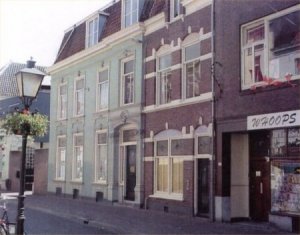
Parapsychologisch Instituut 7 Springweg, Utrecht After the conference, presenters, speakers and attendees walked the few short blocks to the Parapsychologisch Instituut where the Parapsychology Foundation hosted the reception that closed the conference. For more information on all aspects of Utrecht II, go to the index page in the historical section of this website by clicking here. The index page includes links to the abstracts, biographies, venue information and photo galleries from the Utrecht II conference, as well as to the illustrated conference schedule. With the exception of the photos that appear on the page of abstracts, all of the photos posted were taken at the conference by us and by other speakers and observers. The schedule and the abstract pages contain links to the powerpoints of the speakers as well as to biographical materials. The photo gallery index also contains a link to the closing ceremonies video, as well as links to other photo albums on the conference available on the Web. A year in planning, its success owing both to the generosity of the HJBF and PF and to all the hard work of the organizational teams, the Conference Board and Bureau, the Advisory Committee and Moderator, the invited address givers and paper presenters, not to mention the insightful and energetic discussions among all the attendees both during the conference and afterhours, Utrecht II was, if not a milestone in the future history of the field, then an exciting and inspiring event that we will not soon forget. ***************** |
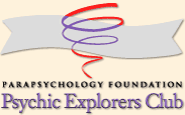 |

|
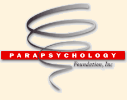 www. parapsychology. org |
||